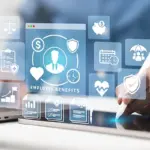by Amanda Milewski
There is a shrinking segment of society that remembers what it was like to gather around a radio in the parlor for entertainment. In time, the same will be said for people who conducted research by cracking open a volume of the Encyclopedia Britannica, popped a cassette tape into a car stereo or called a friend from a telephone hanging on the wall.
Much of the population has never even heard of those things. All they know is in the palms of their hands, and many of them are hyperconnected to a fault.
There is no question that some connectivity makes everyday life convenient and efficient.
You can find the answer to any question with a quick internet search. You can bank, order groceries and dinner, send and receive money, read a magazine or a book, listen to a podcast, watch a movie, catch up on news, check the weather and see who is at your front door, all from your phone.
And that’s just what you initiate. Numerous other things are incoming: dings from email, texts, social media posts, reminders, calendar updates, severe weather alerts, breaking news stories, sales alerts and, of course, actual phone calls.
“I think almost every young person and every working adult is hyperconnected,” says Tina Hoff, software integration analyst at Carroll Community College. “Hyperconnectivity means that everyone and everything is now connected to the internet 24/7 through devices.”
For working adults, hyperconnectivity is almost essential. And for those who work remotely, being connected and available all day and even into the evening is critical to maintaining solid working relationships and facilitating productivity.
“Being on the tech side is hard,” Hoff concedes. “We feel like we have to be available 24/7 since the college is open for daytime classes, evening classes and weekend classes. So yes, some of that is necessary. But when you add that connectivity to all the other kinds we are exposed to, it can be too much.”

– Tina Hoff
Most adults would agree that being connected 24/7 is too much. But do kids share that opinion? Young people, many of whom played on Mommy’s tablet as toddlers and who had a smartphone as soon as they were old enough not to lose it, are growing up hyperconnected.
“Kids are hyperconnected because that’s how they work, play and connect with their friends,” says Hoff. “Even when they are offline and hanging out with friends, everyone is pulling up videos, Instagram posts and memes on their phones and talking about them.”
This is a widespread trend. A 2018 Pew Research Center survey found that 45 percent of teens said they use the internet “almost constantly” while 44 percent said that they go online “several times a day.” Gender was a factor, with 50 percent of teenage girls claiming they are “near constant” online users as compared to 39 percent of teenage boys.
But some kids are aware of the negative impacts of this way of living. In 2016, a Common Sense Media Report found that half of teens surveyed “feel addicted” to their mobile devices. Of the respondents, 72 percent of teens feel the need to respond to texts, social media messages and notifications immediately. Seventy-eight percent of teens surveyed checked their mobile devices at least hourly.
A 2012 study also by Pew sought the opinions of technology experts about whether teens’ hyperconnectivity would be a positive or negative thing in 2020. At the time, respondents were split almost evenly on whether it would be good or bad.
Half noted that young people who are hyperconnected will be “nimble, quick-acting multitaskers who will do well in key respects.” The other half said that young peoples’ hyperconnectivity will cause them to “thirst for instant gratification, settle for quick choices and lack patience.”
The future of that study is now, and Monica Zilioli, assistant professor of psychology at Carroll Community College, agrees more with the latter group of survey respondents. “I think students overestimate how well they can multitask,” she says. “I see this when I give assignments where there is more creative freedom. Many students dislike open-ended assignments and want to know exactly what I want. I think this stems from the immediate gratification mentality and dislike of ambiguity.”
Zilioli admits she isn’t a fan of technology, but she takes a balanced approach in her classes. “I understand that many of my students grew up with [technology]. So I must have a certain level of hyperconnectivity knowledge so I can teach in a way that they find accessible. Plus, the good and bad aspects of hyperconnectivity are essential to address in psychology.”
Still, Zilioli does set limits on the use of devices during class. “I encourage students to be off their phones during class,” although she acknowledges that this has been difficult since they are learning remotely. She implemented activities that assess class participation and she also makes extra an effort to get students to turn their cameras on during remote classes. “I tell them that if [they] want to work in the mental health field, it is best if [they] are comfortable interacting virtually and face-to-face. Psychology jobs are largely not data-entry jobs so it is good practice.”
Community college classrooms typically have students who vary widely in age. Zilioli’s approach benefits younger students as well as older ones, who she says are initially anxious about the technology she uses, but eventually come to feel more comfortable.
“Most older students see that education has changed,” Zilioli says, “so they understand that they cannot rely on the old ways of doing things. They adapt!”
Zilioli is reluctant to label all young people hyperconnected and all older folks as nontech-savvy. “I know some older folks who are way more tech-savvy and involved on social media than me. Likewise, I have younger students who dislike all of the technology. I believe much of this comes down to personality. Many of my more extraverted students are not as hyperconnected in class because they enjoy the face-to-face interactions. In contrast, many of my more introverted students feel more comfortable interacting through their devices.”
Personality, age and gender aside, there are definitely those who are unhealthily hyperconnected, but at what point does it become detrimental? Both Hoff and Zilioli agree it is hard to pinpoint that, in part because, as Zilioli points out, “The harm of technology can be gradual and insidious. I’d say technology is harmful if it has overtaken our life and we are depending on it.”
Want to digitally detox?
Are you feeling too connected and need a break from screens? Or maybe you want to establish better digital habits so you don’t become overly connected?
Monica Zilioli of Carroll Community College suggests scheduling time to spend on social media. She also is “a big proponent of occasional social media cleanses, where you uninstall certain apps for a time. I also think it is good to put limits on when you should not be on your device — for example, at dinnertime.”
Tina Hoff and her family turned off almost all notifications on their devices, a suggestion made by tech engineers in the documentary The Social Dilemma, which they recently watched.
“Getting ‘dinged’ with a sound or a visual alert every time something new hits an app makes you feel anxious unless you respond,” Hoff says.
She also uses the “do not disturb” feature on her phone that silences calls and notifications from 9 p.m. to 6 a.m. “I also try not to check my phone when I work out, take a lunch break or wrap up work for the day.”
Ironically, there are apps to help with a digital detox.
Some track how much time you spend on a device, and others actually lock your device for a certain period of time. An app called Forest rewards you for time spent off your phone and enables you to plant real trees in Africa.
“I used to feel hyperconnected almost all of the time,” says Hoff. “But I have made a conscious effort to unplug as much as I can during the evenings with my family. I also work out regularly and do a meditation class once a week to completely unplug from everything. The more time I build in to ‘disconnect,’ the harder it is to go back to the frantic pace of hyperconnectivity.”
“When you are required to be online and connected to do your job, to manage your bills and tasks of daily life, and to keep up with friends and family, how do you judge?” Hoff asks. “It seems more harmful if you don’t keep up with things. And if you use technology to connect with hobbies or interests or to read the news or an e-book, how can that be a bad thing? I think as individuals and as a society, we haven’t even begun to answer that important question.”
The harm from hyperconnectivity can manifest itself both physically and mentally. Some physical symptoms include digital motion sickness, that woozy feeling from scrolling too quickly or watching an action movie on a device; text claw, the cramping of fingers, hands and lower arms from too much device usage; eye strain; and text neck, pain in your neck and spine from looking down at a device for long periods.
“When I am hyperconnected for more than a few days, I can’t relax,” Hoff says. “I feel anxious, unable to sit still or keep my hands off my phone. I feel like I’m forgetting something or missing something. After too much connectivity, it’s scary how much I lose the ability to do more meaningful tasks.”
Not only is hyperconnectivity sometimes the issue but also to what users are hyperconnected. Zilioli says, “I discuss with my students how social media constantly provides a platform for social comparison. This can lead to low self-esteem, depression and anxiety.” She also notes that a false sense of reality, poor sleep, increasing isolation, missing work or school, and conflict in relationships can all be signs of being overly connected. “I’d also add that any time spent on technology that impairs your ability to complete schoolwork or do your job is a warning sign.”
There is no denying that technology helped during the COVID pandemic, whether it was through critical efforts like maintaining connections with loved ones, virtual learning, working remotely and telehealth visits, to everyday tasks like banking, ordering groceries, household supplies and meals, attending online fitness classes or watching live-streamed events.
Despite our reliance on technology during the pandemic, Hoff believes there will be a backlash against being hyperconnected in our personal lives. Zilioli believes it has already started.
“Many people already realize how important it is to have face-to-face interactions and downtime away from screens,” Zilioli says. Lots of parents have seen how virtual learning has been a struggle for their kids. Likewise, when I ask for feedback about my classes, student overwhelmingly express wanting to be back in the physical classroom.”
As far as the workplace goes, both Hoff and Zilioli believe that some changes are here to stay. “Workplaces realized how much employees can actually get done remotely and how easily you can get people ‘in a room’ they’re only a click away,” says Hoff. “More employers may offer work-from-home options now. But there will have to be a balance. Employees need [a] balance between being available 24/7 and ‘leaving work at the office’ at the end of the day. Maybe now we can talk openly about where to go from here,” she hopes.













